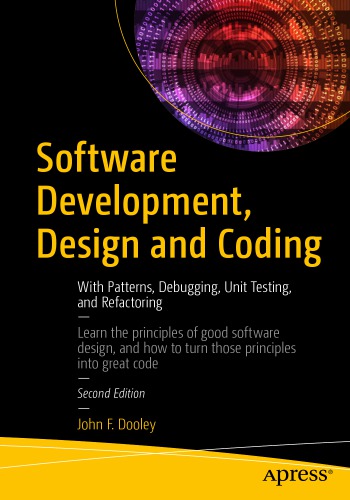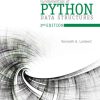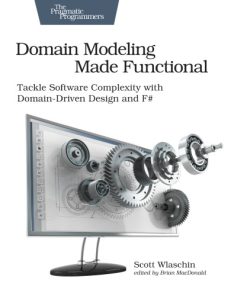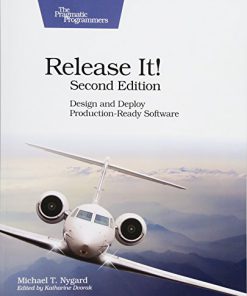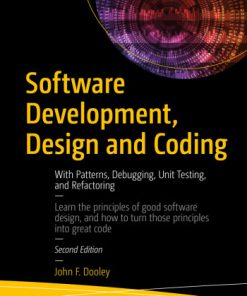Software Development Design and Coding 2nd by Dooley 9781484231524 1484231538
$50.00 Original price was: $50.00.$25.00Current price is: $25.00.
Software Development, Design and Coding 2nd by John F. Dooley – Ebook Instant Download/Delivery ISBN: 9781484231524 , 1484231538
Product details:
Table of contents:
Chapter 1: Introduction to Software Development
What We’re Doing
So, How to Develop Software?
Conclusion
References
Chapter 2: Software Process Models
The Four Variables
A Model That’s not a Model At All: Code and Fix
Cruising over the Waterfall
Iterative Models
Evolving the Iterative Model
Risk: The Problem with Plan-Driven Models
Agile Methodologies
Agile Values and Principles
eXtreme Programming (XP)
XP Overview
The Four Basic Activities
Implementing XP: The 12 Practices
Scrum
Scrum Roles
The Sprint
Scrum Artifacts
Sprint Flow
Lean Software Development
Principle 1: Eliminate Waste
Principle 2: Build Quality In
Principle 3: Create Knowledge
Principle 4: Defer Commitment
Principle 5: Deliver Fast
Principle 6: Respect People
Principle 7: Optimize the Whole
Kanban
The Kanban board, WIP, and Flow
Lead Time
Conclusion
References
Chapter 3: Project Management Essentials
Project Planning
Project Organization
Risk Analysis
Resource Requirements
Task Estimates
Project Schedule
Velocity
Project Oversight
Status Reviews and Presentations
Defects
The Retrospective
Conclusion
References
Chapter 4: Requirements
What Types of Requirements Are We Talking About?
User Requirements
Domain Requirements
Non-Functional Requirements
Non-Requirements
Requirements Gathering in a Plan-Driven Project
But I Don’t Like Writing!
Outline of a Functional Specification
Overview
Disclaimer
Author’s Name
Scenarios of Typical Usage
Open Issues
Design and New Feature Ideas
One More Thing
Requirements Gathering in an Agile Project
The Three Cs
Card
Conversation
Confirmation
INVEST in Stories
Independent
Negotiable
Valuable
Estimable
Small
Testable
Product Backlog
SMART Tasks
Specific
Measurable
Achievable
Relevant
Time-Boxed
Sprint/Iteration Backlog
Requirements Digging
Why Requirements Digging Is Hard
Problems of Scope
Problems of Understanding
Problems of Volatility
Non-Technical Problems
Analyzing the Requirements
Conclusion
References
Chapter 5: Software Architecture
General Architectural Patterns
The Main Program—Subroutine Architectural Pattern
Pipe-and-Filter Architecture
An Object-Oriented Architectural Pattern
An MVC Example: Let’s Hunt!
The Problem
Model
View
Controller
The Client-Server Architectural Pattern
The Layered Approach
Conclusion
References
Chapter 6: Design Principles
The Design Process
Desirable Design Characteristics (Things Your Design Should Favor)
Design Heuristics
Designers and Creativity
Conclusion
References
Chapter 7: Structured Design
Structured Programming
Stepwise Refinement
Example of Stepwise Refinement: The Eight-Queens Problem
Proposed Solution 1
Proposed Solution 2
Proposed Solution 3
Refinement 1
Refinement 2
Modular Decomposition
Example: Keyword in Context
Top-Down Decomposition
Modular Decomposition of KWIC
Conclusion
References
Chapter 8: Object-Oriented Overview
An Object-Oriented Analysis and Design Process
Requirements Gathering and Analysis
Design
Implementation and Testing
Release/Maintenance/Evolution
Doing the Process
The Problem Statement
The Feature List
Use Cases
Decompose the Problem
Class Diagrams
Code Anyone?
Conclusion
References
Chapter 9: Object-Oriented Analysis and Design
Analysis
An Analytical Example
Design
Change in the Right Direction
Recognizing Change
Songbirds Forever
A New Requirement
Separating Analysis and Design
Shaping the Design
Abstraction
Conclusion
References
Chapter 10: Object-Oriented Design Principles
List of Fundamental Object-Oriented Design Principles
Encapsulate Things in Your Design That Are Likely to Change
Code to an Interface Rather Than to an Implementation
The Open-Closed Principle
The Don’t Repeat Yourself Principle
The Single Responsibility Principle
The Liskov Substitution Principle
The Dependency Inversion Principle
The Interface Segregation Principle
The Principle of Least Knowledge
Class Design Guidelines
Conclusion
References
Chapter 11: Design Patterns
Design Patterns and the Gang of Four
The Classic Design Patterns
Patterns We Can Use
Creational Patterns
The Singleton Pattern
The Factory Method Pattern
Structural Patterns
The Adapter Pattern
The Façade Pattern
Behavioral Patterns
The Iterator Pattern
The Observer Pattern
The Strategy Pattern
Conclusion
References
Chapter 12: Parallel Programming
Concurrency vs. Parallelism
Parallel Computers
Flynn’s Taxonomy
Parallel Programming
Scalability
Performance
Obstacles to Performance Improvement
How to Write a Parallel Program
Parallel Programming Models
Designing Parallel Programs
Parallel Design Techniques
Programming Languages and APIs (with examples)
Parallel Language Features
Java Threads
OpenMP9
The Last Word on Parallel Programming
References
Chapter 13: Parallel Design Patterns
Parallel Patterns Overview
Parallel Design Pattern Design Spaces
Finding Concurrency
Algorithm Structure
Supporting Structures
Implementation Mechanisms
A List of Parallel Patterns
Embarrassingly Parallel
Master/Worker
Map and Reduce
MapReduce
Divide & Conquer
Fork/Join
A Last Word on Parallel Design Patterns
References
Chapter 14: Code Construction
A Coding Example
Functions and Methods and Size
Formatting, Layout, and Style
General Layout Issues and Techniques6
White Space
Block and Statement Style Guidelines
Declaration Style Guidelines
Commenting Style Guidelines
Identifier Naming Conventions
Refactoring
When to Refactor
Types of Refactoring
Defensive Programming
Assertions Are Helpful
Exceptions
Error Handling
Exceptions in Java
The Last Word on Coding
References
Chapter 15: Debugging
What Is an Error, Anyway?
What Not To Do
An Approach to Debugging
Reproduce the Problem Reliably
Find the Source of the Error
Debugging Tools
Gdb
Eclipse
XCode
Fix the Error (Just That One)!
Test the Fix
Look for More Errors
Source Code Control
The Collision Problem
Using Lock-Modify-Unlock
Using Copy-Modify-Merge
Source Code Control Systems
Subversion
Git and GitHub
Mercurial
One Last Thought on Coding and Debugging: Pair Programming
Conclusion
References
Chapter 16: Unit Testing
The Problem with Testing
That Testing Mindset
When to Test?
Testing in an Agile Development Environment
What to Test?
Code Coverage: Test Every Statement
Data Coverage: Bad Data Is Your Friend?
Characteristics of Tests
How to Write a Test
The Story
The Tasks
The Tests
JUnit: A Testing Framework
Testing Is Good
Conclusion
References
Chapter 17: Code Reviews and Inspections
Walkthroughs, Reviews, and Inspections
Walkthroughs
Code Reviews
Code Inspections
Inspection Roles
Inspection Phases and Procedures
Planning
The Overview Meeting
Preparation
The Inspection Meeting
Inspection Report
Rework and Follow-up
Reviews in Agile Projects
How to Do an Agile Peer Code Review
Summary of Review Methodologies
Defect Tracking Systems
Defect Tracking in Agile Projects
Conclusion
References
Chapter 18: Ethics and Professional Practice
Introduction to Ethics
Ethical Theory
Deontological Theories
Consequentialism (Teleological Theories)
Ethical Drivers
Legal Drivers
Professional Drivers
Preamble to the ACM/IEEE-CS Software Engineering Code of Ethics
Ethical Discussion and Decision Making
Identifying and Describing the Problem
Analyzing the Problem
Case Studies
#1 Copying Software
#2 Who’s Computer Is It?
#3 How Much Testing Is Enough?
#4 How Much Should You Tell?
The Last Word on Ethics?
References
The ACM Code of Ethics and Professional Conduct
Preamble
Contents & Guidelines
1. GENERAL MORAL IMPERATIVES
1.1 Contribute to society and human well-being
1.2 Avoid harm to others
1.3 Be honest and trustworthy
1.4 Be fair and take action not to discriminate
1.5 Honor property rights including copyrights and patent
1.6 Give proper credit for intellectual property
1.7 Respect the privacy of others
1.8 Honor confidentiality
2. MORE SPECIFIC PROFESSIONAL RESPONSIBILITIES
2.1 Strive to achieve the highest quality, effectiveness and dignity in both the process and product
2.2 Acquire and maintain professional competence
2.3 Know and respect existing laws pertaining to professional work
2.4 Accept and provide appropriate professional review
2.5 Give comprehensive and thorough evaluations of computer systems and their impacts, including ana
2.6 Honor contracts, agreements, and assigned responsibilities
2.7 Improve public understanding of computing and its consequences
2.8 Access computing and communication resources only when authorized to do so
3. ORGANIZATIONAL LEADERSHIP IMPERATIVES
3.1 Articulate social responsibilities of members of an organizational unit and encourage full accep
3.2 Manage personnel and resources to design and build information systems that enhance the quality
3.3 Acknowledge and support proper and authorized uses of an organization’s computing and communic
3.4 Ensure that users and those who will be affected by a system have their needs clearly articulate
3.5 Articulate and support policies that protect the dignity of users and others affected by a compu
3.6 Create opportunities for members of the organization to learn the principles and limitations of
4. COMPLIANCE WITH THE CODE
4.1 Uphold and promote the principles of this Code
4.2 Treat violations of this code as inconsistent with membership in the ACM
The ACM/IEEE-CS Software Engineering Code of Ethics
PREAMBLE
PRINCIPLES
Chapter 19: Wrapping It all Up
People also search:
what is the difference between coding and software development
bd software development program
difference between coding and software development
c software development
fdm software developer salary
You may also like…
Computers - Computer Science
Cookbooks
Computers - Programming
Computers - Programming
Computers - Applications & Software
Embedded Software Development for Safety-Critical Systems 2nd Edition Chris Hobbs
Computers - Programming


